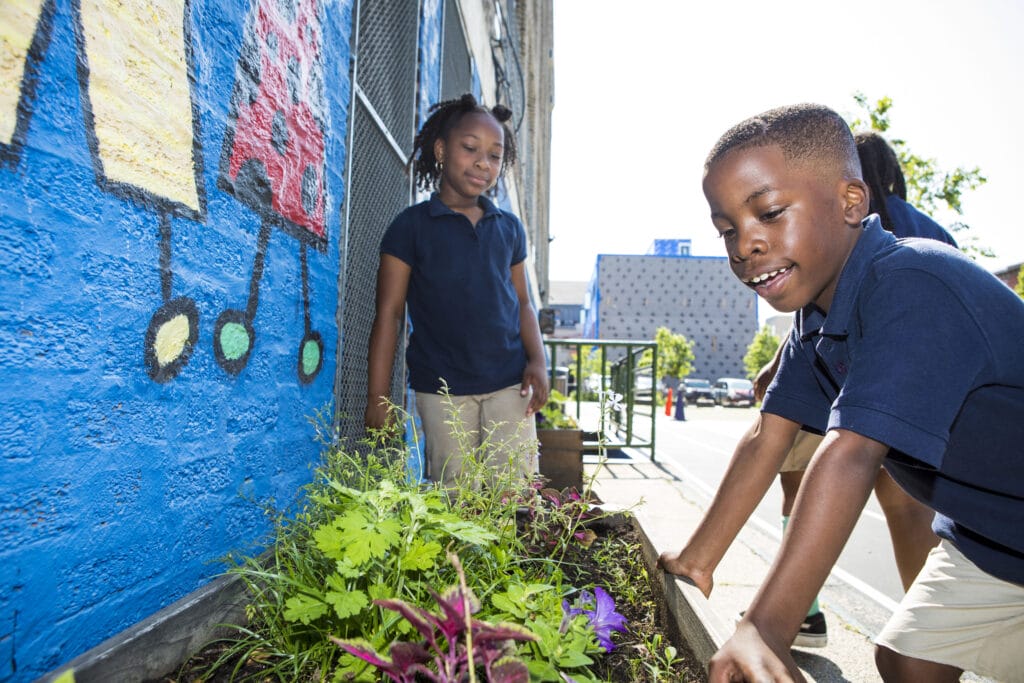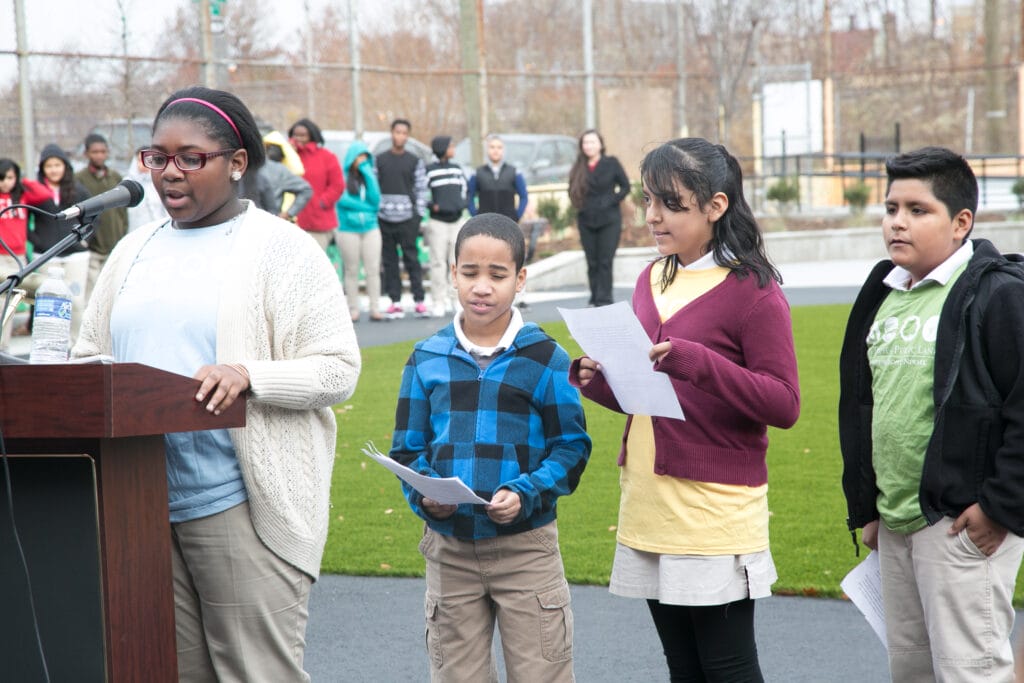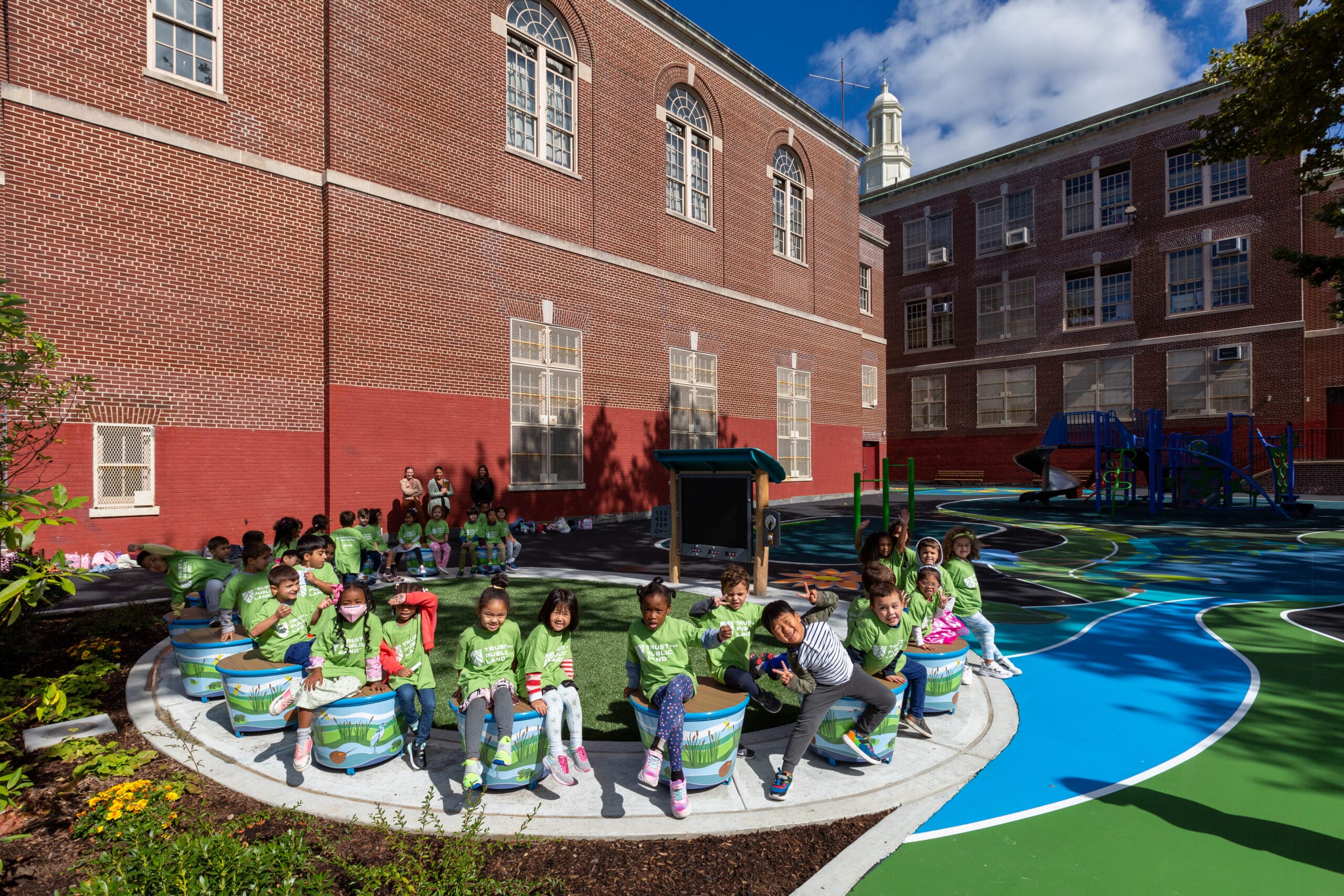At Stonewall Tell Elementary School outside Atlanta, a new schoolyard is being designed with a suite of cool features: a shade pavilion, benches, climbing equipment, a path marked with sprinting distances that connects to the school building, and outdoor musical instruments like drums and chimes.
An equally impressive feature, though perhaps less visible, was the way the project involved students. A bimonthly afterschool club was created to help guide the process, and students from all grades joined. They met with Trust for Public Land staff, who are leading the project, to survey the site. They studied the slant of sunlight and shadows, as well as the flow of rainwater. They pored over maps and charts. They considered amenities that both the student body and wider community would enjoy, since the schoolyard will be open to the public after school and on weekends. Finally, they chose a conceptual plan that a designer will now bring to life.
“This is a tangible project, not something we will display for a few months and then have to remove,” says Nikki Porter, the school principal, of the future schoolyard. “It will be here and part of this community for years to come. The students initiated the schoolyard project, presented it to the community, and had their ideas represented in the design. That’s a significant learning experience.”

Across the country, Trust for Public Land is helping schools rip out asphalt or otherwise drab schoolyards and replace them with green, welcoming spaces that double as neighborhood parks. From Georgia to New York to Washington State, we’ve transformed nearly 300 schoolyards through our Community SchoolyardsTM initiative to date. In each project, students engage in what is known as “participatory design,” surveying fellow students and neighbors and working alongside professional landscape architects.
The schoolyards thus become civic labs of a kind, in which students learn how to advocate for themselves, their schools, and their communities. They also receive a crash course in arcane subjects like stormwater management and urban heat islands, in which concrete and pavement absorb and cling to heat longer than natural surfaces. Crucially, they discover how a well-designed schoolyard—with features like trees, rain gardens, and absorbent turf fields—can mitigate these growing problems.
Danielle Denk, TPL’s Community Schoolyards initiative director, says the schoolyards program was a natural addition to a school’s curriculum. “Democracy happens in the public realm, not on someone’s computer,” she says. “It happens when we all get together and share our goals.”
“That children have the voice and ability to make decisions about what the public realm can look like is very powerful.”
She adds that when students have the opportunity to design tangible, nature-based solutions to the climate crisis—in their own schoolyard—they bear witness to their power to make positive change. This goes a long way to reducing eco-anxiety.
Stonewall Tell Elementary is one of a dozen schoolyard projects in Atlanta and the surrounding area. Five schoolyards are complete; three are under construction, two are awaiting construction permits. Two more, including the one at Stonewell Tell, are in design. Ruth Pimentel, TPL’s Georgia community schoolyards program coordinator, was struck by the students’ concern for potential users of the space.
“At the opening meeting, we had them list everyone who might use this park,” she recalls. “They were really broad in thinking about who might want to come by this space and then what they might need. As the process continued, it was impressive how they remembered and advocated for the needs of others.”
While the students at Stonewall Tell met in an afterschool club, in most school districts where TPL works, two or more classrooms are designated to lead the schoolyard transformation. Such was the case in Newark, New Jersey, where a fourth and fifth grade class were tasked with designing the schoolyard at the Luiz Muñoz Marín School, which serves more than 800 students in grades pre-K through 8.
The school is one of 10 in the state’s largest city, where TPL has overseen schoolyard renovations. (In 1999, our very first schoolyard made its debut there.) At Marín School, the 1-acre schoolyard is long and narrow, so students had to work within the confines of a linear site. Heidi Cohen, a senior program manager for TPL in Newark, says students had settled on a number of elements: ornamental gardens, raised vegetable beds, new play equipment, a half basketball court, a synthetic turf field (designed to capture rainwater), a lawn area, and a climbing wall.
“This is our biggest effort yet,” Cohen says of the Marín schoolyard project.
Kenneth Montalbano, executive assistant to the superintendent of the Newark Public Schools, was principal of Marín Elementary during the early stages of the project. He remembers dropping by some of the design workshops, which were led by an architect who had constructed a 3-D model of the school’s building and outdoor spaces.
“So many times students have to go with the flow and follow the rules, which are obviously important,” Montalbano says. “But I think this process gave them a sense of empowerment. The most transformative environments for students let them see that their actions can actually help people and result in something concrete. That kind of lesson is really what school is all about.”
He points out that the schoolyard under design will be used by students in pre-kindergarten through the second grade. The fourth and fifth graders who helped design the space, then, will not necessarily get to enjoy it—unless they return after school hours when it is built. “They entered the process knowing that and still gave it 110 percent,” he notes.
Students themselves give the design process high marks. Arianna McDowell is a former fourth grader at Lincoln Elementary School in Newark, where a new schoolyard is scheduled to open next spring. “It was a good program to be in,” she says. “I could express my ideas to other people and help to make a change for our school.”
Daniel Valle, a former Lincoln student whose family emigrated from Colombia, agreed, saying his participation in the schoolyard’s creation made him “feel more connected to my community.”
In Tacoma, Washington, Trust for Public Land has spearheaded five schoolyard renovations. They were chosen based on public health measures and 10-minute walk access (the percentage of residents whose homes are located within a short walk of a park or, in this case, a school).
Vinita Sidhu is a landscape architect and principal of Site Workshop, the firm hired to remake the Tacoma schoolyards. She worked with third-grade classrooms in two separate schools. For both, she explained what a landscape architect does and gave each child an aerial plan of the existing schoolyard. Then she presented them with images of possible amenities (swing set, trees, picnic table, murals) and asked them to conjure their dream schoolyard. Working in groups, the students cut the images out with scissors and glued them onto their plans.
Sarneshea Evans, TPL’s Northwest Parks for People program director, says the workshops provided a lesson in collaboration, while serving as a gentle introduction to public speaking. “After finishing the plans, one child from each group volunteered to present their design,” she explains.
Similarly, in Atlanta, students in one school drafted letters to the Board of Education to argue for funding for a new schoolyard. Others shared their designs on a Zoom call with the director and staff of the Atlanta Public Schools’ Facilities Services Department. Across the country, students are among the speakers during the schoolyard ribbon-cutting ceremonies.
 Sidhu in Tacoma sees still other lessons. “From an educational perspective, regardless of what’s built, students are learning about conceptual thinking, and that is a useful tool,” she observes. “Who knows how this might change their path?” Adding that the Tacoma schools were in high-need neighborhoods, she added: “I hope they walk away seeing how change can be affected.”
Sidhu in Tacoma sees still other lessons. “From an educational perspective, regardless of what’s built, students are learning about conceptual thinking, and that is a useful tool,” she observes. “Who knows how this might change their path?” Adding that the Tacoma schools were in high-need neighborhoods, she added: “I hope they walk away seeing how change can be affected.”
Lisa W. Foderaro is a senior writer and researcher for Trust for Public Land. Previously, she was a reporter for the New York Times, where she covered parks and the environment.
Rising temperatures, bigger storms, and asphalt schoolyards pose significant risks during recess. Urge Congress to prioritize schoolyards that cool neighborhoods, manage stormwater, and provide opportunities for kids to connect with nature today!

Donate to become a member, and you’ll receive a subscription to Land&People magazine, our biannual publication featuring exclusive, inspiring stories about our work connecting everyone to the outdoors.

